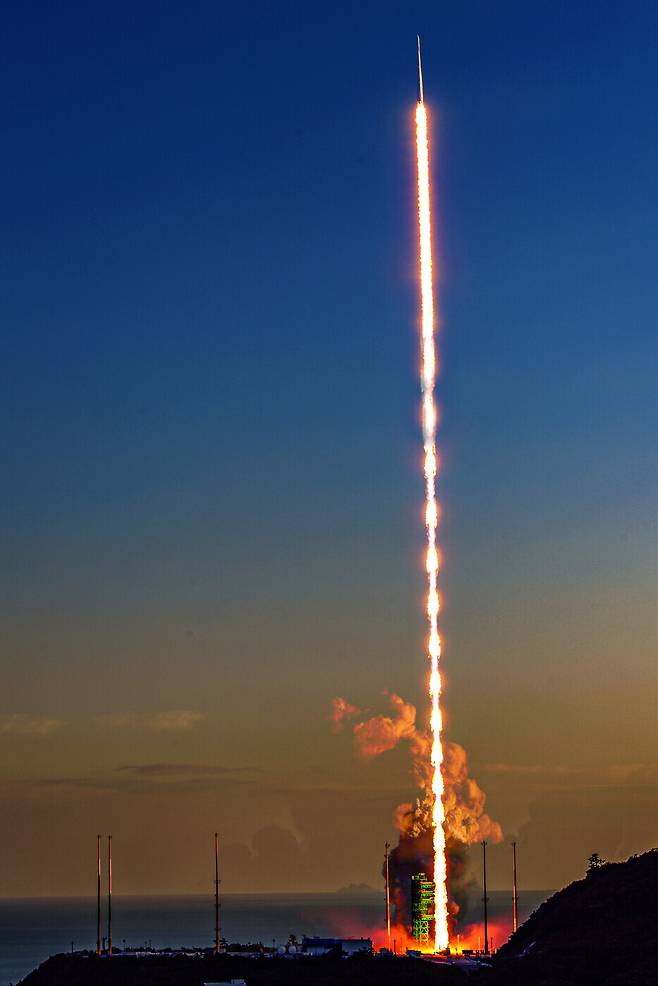[Editorial] Nuri launch is small step for S. Korea's autonomous leap into space
이 글자크기로 변경됩니다.
(예시) 가장 빠른 뉴스가 있고 다양한 정보, 쌍방향 소통이 숨쉬는 다음뉴스를 만나보세요. 다음뉴스는 국내외 주요이슈와 실시간 속보, 문화생활 및 다양한 분야의 뉴스를 입체적으로 전달하고 있습니다.

At 5 pm Thursday, the Nuri rocket headed into space from its launch pad at the Naro Space Center in Goheung, South Jeolla Province. The first- and second-stage boosters separated normally, sending the rocket 700 km above the earth’s surface, where it released a 1.5-ton dummy satellite that it was carrying.
Unfortunately, that dummy satellite failed to enter its designated orbit, which means the test launch was only half successful. Even so, it’s a major achievement for a first launch, where the average success rate is below 30 percent.
It was thrilling enough to see Nuri’s exquisite flight that day. We applaud all those who participated in its development and launch for their hard work.
It’s by no means easy for a country to establish its own independent space transportation capabilities. Since a launch vehicle operates according to the same principles and structure as a missile, countries that possess the technology place limits on the exportation of technology transfer-related items in the interests of security strategy.
In South Korea’s case, the first Naro satellite launch vehicle, which was developed with Russia’s technological collaboration, was successfully launched in 2013 after three tries. The Nuri project was begun in 2010 as an independent development effort.
The entire process for the Nuri — from its design to its production, testing, and launch — was done with South Korean technology. Nearly 2 trillion won (US$1.69 billion) was invested in it, up to and including the launch.
The vehicle was assembled from around 370,000 components, which were produced by marshaling the full capabilities of South Korean industry, academia, and research, including those of the Korea Aerospace Research Institute and the 300 or so private businesses that took part.
It is unfortunate that the dummy satellite could not be put into orbit as the third-stage engine stopped working earlier than scheduled during the launch. But a meal is about more than just the first spoonful. The next step is simply to find and fix the cause of the problem so that the next launch is a complete success.
Nuri is expected to show its capabilities with its second launch in May 2022 and another four launches through 2027. Here’s hoping that the second launch conclusively shows that South Korea has the capabilities to become the seventh country in the world to launch a practical satellite weighing over a ton.
From the Soviet Union’s Sputnik 1 satellite in 1957 through the US Apollo 11 spacecraft’s moon landing in 1969, human explorations of space have continued to develop to the point where we have recently been able to send probes to Mars and usher in an era of private space travel.
But South Korea’s technological capabilities are still seen as lagging behind those of the US, China, or Japan by around 10 to 20 years. There’s a long road ahead for us to show our launch capabilities and to achieve commercial uses and competitiveness.
Our first goal should be the successful launch of the Nuri. From there, we can use that as a springboard toward even greater leaps forward.
Please direct questions or comments to [english@hani.co.kr]
Copyright © 한겨레. 무단전재 및 재배포 금지.
- 경보음 20번 "묵살"..기계 끼어 숨진 날, 현장지휘자도 없었다
- 국힘, 배임 빠진 유동규 기소에 "공작적 기소 용납 못해"
- 내전의 비극 속 '애달픈' 진화..코끼리는 '상아' 없이 태어났다
- '전두환 망언' 유감이라더니 '개에게 사과 주는 사진' 올린 윤석열 캠프
- 이재명, 5·18 묘지 전두환 비석 밟고 "학살반란범"
- "생수병서 독극물 검출 안 돼"..커지는 '생수병 사건' 미스터리
- "단계적 일상 회복은 사회적 약자의 인권 중심이어야 한다"
- 마동석 기자간담회에 깜짝 등장한 앤절리나 졸리 "난 마동석 팬"
- 스토킹처벌법 시행 첫날, 헤어진 연인 집 찾아간 남성 현행범 체포
- 오세훈 "따릉이 3천대 도입" 급선회..전 시장 지우기 의식?